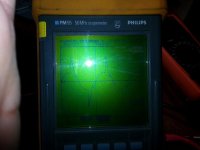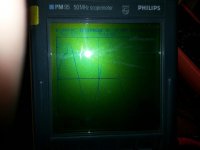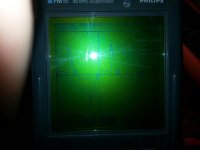snugmonster
Member
Quite a bit of recent reading tells me that convenient speed control of a split phase 115VAC motor is either impossible or not practical. I hope that's not the case.
I have a circa 1970/80 Craftsman 1725 RPM 1/2 HP 115VAC split phase motor that I'd like to use for a fan application, mainly as a whole house exhaust fan. I have a LAU propeller on order which flows 2300 CFM at 1725 RPM at .234 HP. I could have gone with a larger prop but I don't want to suck the hummingbirds off the feeders and through the window screens.
I'd like to use a speed controller to allow drawing a decent breeze through the windows during the day and decrease the noise a bit at night, as the fan will be located in the 2nd floor near the bedrooms' open doors. I'd like to use something like the triac based KBWC-18K due to cost/availability:
http://www.kbelectronics.com/data_sheets/kbwc_data_sheet.pdf
Obviously it doesn't list split phase as a supported motor type. It seems the problem revolves around the startup winding and centrifugal switch (abbr. CS). I've performed very rudimentary non scientific testing of the CS dis/engagement. With a bare shaft no load, when I start the motor I hear a click within .5 seconds, and I assume this is the CS disengaging. When I shut the motor down it sheds RPM very rapidly, and I can clearly hear the CS reengage. It seems the RPM of the shaft at CS reengagement is less than 800 RPM. I could be wrong, this is strictly naked eye/ear observation.
So my questions for you sharp folks are:
1. If the only issue with speed controlling split phase motors is centrifugal switch dis/engagement, can this not be solved simply by always starting the motor at full power, and adjusting the minimum speed trimpot so the RPM never drops low enough during operation to reengage the CS?
2. If the issue is something else, would someone be kind enough to explain why the startup winding presents such a problem for solid state speed controllers.
3. The docs for the KB unit state one should use a prop that generates near full load on the motor (SP, PSC, universal) at full RPM for the speed controller to function properly. Is this due to some kind of current draw sensing circuit that's used to adjust the voltage?
4. I've not tested the voltage to RPM linearity of this motor and frankly I don't have the proper equipment to do so. Assuming a speed controller is even a possibility, does anyone know if these old Craftsman motors have a decent enough linearity to attempt using a voltage based speed controller?
My apologies for the length of my first post. I'm new here but not to technical forums. It's usually best to include as much detail as possible up front. In other fora I'm constantly, daily, having to ask for additional details, and the back/forth becomes an impediment to helping the person effectively, timely.
I have a circa 1970/80 Craftsman 1725 RPM 1/2 HP 115VAC split phase motor that I'd like to use for a fan application, mainly as a whole house exhaust fan. I have a LAU propeller on order which flows 2300 CFM at 1725 RPM at .234 HP. I could have gone with a larger prop but I don't want to suck the hummingbirds off the feeders and through the window screens.
I'd like to use a speed controller to allow drawing a decent breeze through the windows during the day and decrease the noise a bit at night, as the fan will be located in the 2nd floor near the bedrooms' open doors. I'd like to use something like the triac based KBWC-18K due to cost/availability:
http://www.kbelectronics.com/data_sheets/kbwc_data_sheet.pdf
Obviously it doesn't list split phase as a supported motor type. It seems the problem revolves around the startup winding and centrifugal switch (abbr. CS). I've performed very rudimentary non scientific testing of the CS dis/engagement. With a bare shaft no load, when I start the motor I hear a click within .5 seconds, and I assume this is the CS disengaging. When I shut the motor down it sheds RPM very rapidly, and I can clearly hear the CS reengage. It seems the RPM of the shaft at CS reengagement is less than 800 RPM. I could be wrong, this is strictly naked eye/ear observation.
So my questions for you sharp folks are:
1. If the only issue with speed controlling split phase motors is centrifugal switch dis/engagement, can this not be solved simply by always starting the motor at full power, and adjusting the minimum speed trimpot so the RPM never drops low enough during operation to reengage the CS?
2. If the issue is something else, would someone be kind enough to explain why the startup winding presents such a problem for solid state speed controllers.
3. The docs for the KB unit state one should use a prop that generates near full load on the motor (SP, PSC, universal) at full RPM for the speed controller to function properly. Is this due to some kind of current draw sensing circuit that's used to adjust the voltage?
4. I've not tested the voltage to RPM linearity of this motor and frankly I don't have the proper equipment to do so. Assuming a speed controller is even a possibility, does anyone know if these old Craftsman motors have a decent enough linearity to attempt using a voltage based speed controller?
My apologies for the length of my first post. I'm new here but not to technical forums. It's usually best to include as much detail as possible up front. In other fora I'm constantly, daily, having to ask for additional details, and the back/forth becomes an impediment to helping the person effectively, timely.








